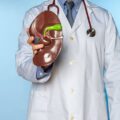COMMENT:
Research into diagnostic alternatives for NASH aims to develop novel and highly effective non-invasive tools (NITs) able to reproducibly stratify patients according to their risks of disease progression in clinical settings and particularly in preparation for NASH trials. Although several effective NITs have been identified for this purpose, few were developed based on machine learning algorithms, which capably pinpoint patterns and create predictions from complex data structures.
This study aimed to employ gradient boosting machine (GBM) learning to develop diagnostic models according to definitions of NASH, at-risk NASH, and significant and advanced fibrosis commonly used in clinical trials. This diagnostic model development relied upon clinical data collected from 966 histologically-characterised NAFLD patients and was supplemented by commonly used NASH biomarkers, e.g. CK-18, PRO-C3/4/6, LSM, and CAP by VCTE.
KEY LEARNINGS:
The GBM-generated composite NASH model, which combined the probabilities of steatosis, inflammation, and ballooning, possessed an AUC of 0.71 without biomarker addition, which did not significantly improve its diagnostic accuracy. In contrast, traditionally used non-invasive NASH markers, including CAP by VCTE and CK-18, exhibited AUCs of 0.64 and 0.61, respectively. Similarly, the composite at-risk NASH model demonstrated an AUC of 0.83, with and without supplementation with biomarkers. Models of significant fibrosis yielded AUCs of 0.76 and 0.78, with and without biomarker addition, respectively. Lastly, the GBM-generated model of advanced fibrosis supplemented by current NASH markers performed significantly better than identical models relying solely upon clinical data (AUCs of 0.86 and 0.82, respectively). These findings highlight the value of building independent machine-learning models for each component of NASH to facilitate its early detection.


Hepatic inflammatory responses in liver fibrosis